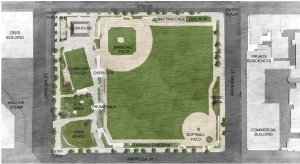
Jackson Playground would be radically altered under a proposed redesign plan. The historic clubhouse would be moved from Mariposa to 17th Street, adjacent to a new community center featuring rooftop tennis courts. The athletic fields would be modified to create a variety of subdivided space, including picnic areas and a batting cage.
Friends of Jackson Park (FoJP), which is spearheading the proposed changes, presented the plan to San Francisco Recreation and Park staff last month. However, before the Department approves it the nonprofit needs to work out financial details. FoJP Executive Director Jude Deckenbach expects a cost estimate to be complete in time for a public presentation in May, with the goal of including the renovation in the 2019 Parks Bond.
“We need to increase the size of the bond, so that’s what we are doing now,” she said. The organization is asking its supporters to contact members of the San Francisco Board of Supervisors and mayoral candidates to advocate for inclusion of park renovation in the bond measure. If it gets into the bond and the bond is approved, Deckenbach said money would be allocated by fall of 2020, with work beginning in 2021 at the earliest.
The redesign plan grew out of a 2016 community outreach effort led by FoJP, which itself organized in 2013 to improve conditions at the park, which hasn’t had a major upgrade in two decades. Among the requests that emerged from the process were a designated children’s play area, dog run, improved alignment between the baseball and softball fields and expansion into Carolina Street, all of which are addressed in the scheme created by Fletcher Studio and Jackson Liles Architecture.
According to research conducted last year by the Citizens Advisory Committee of the Eastern Neighborhoods Plan, the 4.41-acre park attracts more than 2,250 users weekly, a number that’s expected to increase sharply over the next decade. While the park is largely utilized now by groups outside the Hill and schools drawn to the athletic fields, new residents to the area are likely to drive a jump in visitors. In addition to 1010Potrero, the 453 residential units recently constructed at Seventh and 16th streets, on tap are an additional 1,070 units in five nearby planned developments.
Even without bond funds, Friends of Jackson Park will have access to roughly $4.5 million if and when those projects are built. Related California, the developer at 1601 Mariposa, where 299 units are slated, has promised $2 million to the park. Walden Development, which plans 395 units at the old Corovan site between 16th and 17th streets along Mississippi Street, has pledged $1.8 million. A 127-unit development at 88 Arkansas Street, recently purchased by Hong Kong-based Zhuguang Holding Group, has promised $500,000. Ronaldo Cianciarulo, building 172 units at 1301 16th Street, has vouched $100,000. And Tom Murphy, who is erecting 17 condominiums at 540 De Haro Street, has pledged $10,000.
The park also is eligible for user impact fees assessed by the City to mitigate developments’ effects on public services. In 2014, Rec and Park allocated $1.6 million from those fees toward planning and improvements at Jackson Playground.
While FoJP is still crunching numbers, a recently completed renovation of Joe DiMaggio Playground, which featured a new community center, but is less than half the size of Jackson, at two acres, cost $7.5 million.
Landscape architect, David Fletcher, noted that redesign efforts will be expensive, which is why his plan attempts to maximize public areas. “In this project every space counts, so it’s our way to render as much as possible.” Currently, with just a large open field, he said there “is a ton of wasted space not being used.”
The proposal calls for a six-foot extension into Carolina Street, where the community center, clubhouse, children’s playground and an additional designated open space area would be located. A promenade, with low walls and shrubbery, would separate activities. The fence that currently surrounds the park would be removed, allowing easy access to and from all four surrounding streets. To further that end, the existing two-foot elevation would be graded to street level.
The community center would feature a basketball court inside, with tennis courts above, the latter accessed by a sloped walkway that’d feature an overlook suitable for use as an additional picnic area or for viewing baseball games. The community center would connect to the clubhouse via a glassed-inroom.
Preservation of the clubhouse, which was built when the park was established in 1912, was a chief priority of planners. One reason for moving it from the park’s southeast to the northwest corner is to locate it on soil more suitable for a building. According to Fletcher, the shift also opened other opportunities. Relocating the historic structure to 17th Street would help revive its visibility, which has been disappearing as its surrounded by new development. And, it’d allow the edifice to be placed in a friendlier manner. Currently, Fletcher noted that the worst side of it, essentially a blank wall, faces the street.
“We can rotate it and bring it into the public view so we can see it and make it a much better public amenity,” he said. He’d also like to cut a hole in that wall so that the stage inside can serve outdoor use as well.
It’s hoped that by creating a more open and lighter environment people will feel safer using the park’s amenities. The current location, particularly around the public bathrooms, has drawn unsavory activity, including prostitution and drug sales.

